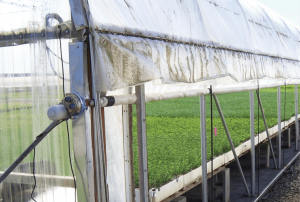How to save money on your energy bills and have a more uniform temperature distribution throughout the greenhouse by embracing roll-up sidewall ventilation.
Roll-up sidewalls have become popular for ventilation of hoophouses and free-standing greenhouses. The main advantages are that they can provide more uniform temperature inside the greenhouse and reduce energy costs by not having to power fans.
Fan ventilation provides positive cooling in all weather, but it sometimes will create a temperature difference between the intake shutter end and the fan end resulting in uneven growth of crops. This can be as much as a 8° F to 10° F difference within 100 feet. Natural ventilation through the sidewalls will result in much smaller differences.
Fans installed at the normal design rate of one volume air change per minute use considerable electricity. Over a year they will use from ½ to 1 kilowatt hour per square foot of floor area depending on your climate. For a 30’ x 100’ hoophouse this amounts to as much as 2500 kilowatt hours costing $375 at a $0.15 electricity rate. Therefore, the relatively quick return on investment that roll-up sidewalls can provide can help pay for the installation cost.
Here are a few tips to follow when installing your system.
 Roll-up systems work best with a greenhouse featuring vertical sidewalls. This keeps most of the rainwater out of the greenhouse. With a quonset shape, the roll-up allows the rainwater to drip inside and can damage plants along the sidewall. Roll-ups also work well if the sidewall faces the prevailing summer wind direction.
Roll-up systems work best with a greenhouse featuring vertical sidewalls. This keeps most of the rainwater out of the greenhouse. With a quonset shape, the roll-up allows the rainwater to drip inside and can damage plants along the sidewall. Roll-ups also work well if the sidewall faces the prevailing summer wind direction.
Install a permanent kneewall. Place it along the greenhouse base up about two feet high to prevent a draft on plants grown on the floor.
A tight seal is needed at the ends to prevent heat loss. The most common method of sealing the end is to close the space between the corner end hoops. A piece of double wall polycarbonate glazing is more permanent than using poly with furring strips or aluminum extrusions.
Install adequate wind straps to retain the sidewall plastic and guide the roll-up operation. Polyester guy rope or webbing lasts longer than nylon. Guy ropes are zig-zagged every four feet from the rail to the baseboard to keep the roll-up from flapping in windy weather. Using a more permanent reinforced plastic is desirable as the roll-up flexes a lot.
Use a minimum 1.315” diameter galvanized steel roll bar. To create a tight seal at the baseboard, a lip out of wood or a special extrusion is used. This reduces air infiltration during cold weather.
Shut off horizontal air flowfans. This can disrupt the wind driven air flow across the greenhouse
Reduce plant handling labor. A large sidewall opening allows easy accessibility for moving plants into or out of the greenhouse.
Size of the sidewall opening to achieve maximum air movement. The American Society of Agricultural and Biological Engineers standards recommend that the sidewall vent area should be at least 15% to 20% of the floor area. For bench crops, a minimum 4” opening will get air movement through the crop area. For taller crops, such s tomatoes or cucumbers, 6” or more is needed. A mid-height roll bar system rolls faster and works better on tall sidewalls.
Consider adding a fan for early season cooling. Especially in northern climates, where snow may be banked up against the sidewall until April. A two-speed, thermostatically operated medium size fan should be installed in one endwall with shutter in the opposite endwall to provide some ventilation.
Consider evaporative cooling. In warm, dry climates its desirable to have evaporative cooling. If the bottom and end seals on the roll-up are tight enough to eliminate air infiltration, an evaporative cooling system with fan and pads will work well.
Automate the system to provide better temperature control. A low voltage gear motor and controller will reduce the labor of manually rolling the sides up and down. A controller that will operate both the heating and cooling systems is best as it eliminates simultaneous operation of equipment.
In some states, roll-ups are eligible for federal, state and local grants, loans and tax credits, including the NRCS – EQIP incentive payment.
